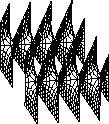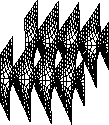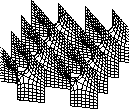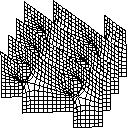

The other surfaces of Scherk's family can be considered as two families of halfplanes meeting at an angle between zero and pi/2. In this case the saddles lying over alternating regions of a plane tiled by rhombi. See the following pictures. If the angle between the halfplane families goes to zero, the Scherk family goes to the helicoid.




Fist of all you have to choose the TASK: CONJUGATE, since this surface is the conjugate of the Scherk tower. Then you should load the status-file k_lsss_g.st to see the computed piece of the surface. This piece is bounded by four straight lines. Now carry out two 180-degree rotations around the both horizontal straight lines. Then you should read in the patch-status-file. After an additional 180-degree rotation around a vertical straight line you see the fundamental domain of translation of this surface. If you want to see a larger part of the surface, you can continue to rotate around vertical straight lines.
 Return to the surface list.
Return to the surface list.
 Return to the project list.
Return to the project list.
 Go back to the main menu.
Go back to the main menu.